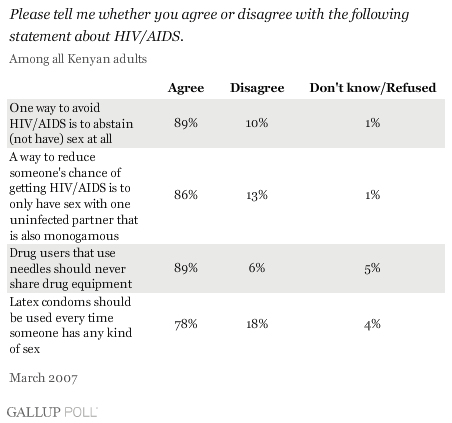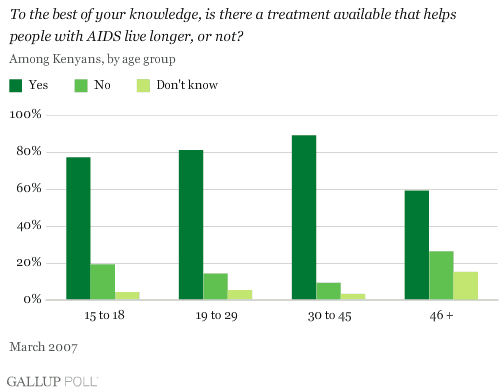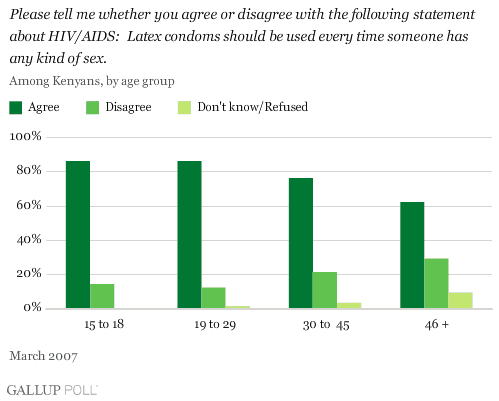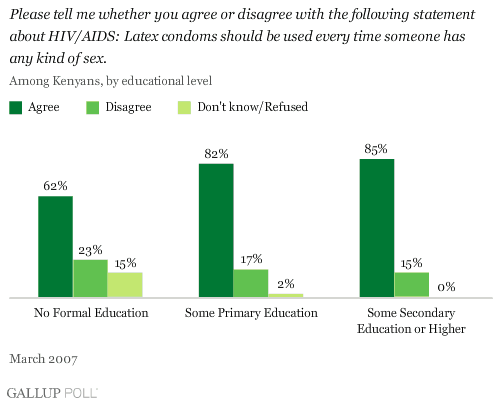WASHINGTON, D.C. -- Leaders and citizens will gather Saturday for World AIDS Day to raise awareness about the disease, which UNAIDS/WHO estimates has killed about 2 million people worldwide this year. In sub-Saharan Africa, home to nearly 70% of people living with HIV, the effects have been particularly severe. Governments and organizations throughout the region have responded to the crisis with measurable success and failure.
In Kenya, it appears that the government's program is starting to pay off. In the early 1990s, the number of new infections among Kenyan adults reached 200,000 per year. In 2000, the Kenyan government developed a multi-faceted program to emphasize prevention, treatment, and mitigation of the social and economic effects of the disease. Today, the number of new infections is closer to 50,000. Although much remains to be done, a recent report from UNAIDS attributes some of the decline in the number of new infections in Kenya to "a reduction in risky behaviours."
To gauge the level of public awareness about HIV/AIDS in Kenya, Gallup asked respondents in March 2007 about their attitudes toward treatment and prevention of the disease. Almost all Kenyans (95%) know that there is no cure for AIDS, while 2% believe a cure exists and 3% say they do not know. Although more than three-quarters of Kenyans (78%) know that a treatment that enables AIDS patients to live longer is available, 16% of respondents do not think such a treatment exists and 6% say they do not know. Overall, large majorities agree that abstinence (89%), non-sharing of needles among drug users (89%), monogamous sex with an uninfected partner (86%), and use of latex condoms (78%) are ways to reduce chances of getting the virus.

Levels of Awareness Differ
Kenyans' awareness about some of the ways to prevent and treat HIV/AIDS varies by gender, age, and education. Women (92%) are more likely to agree than men (79%) that monogamous sex with an uninfected partner can reduce the chance of getting HIV/AIDS. Older Kenyans are the least likely to be aware that a treatment to extend the lives of AIDS patients is available. Fifty-nine percent of those aged 46 and older think such a treatment exists, while 26% do not believe it exists and 15% of respondents do not know. In comparison, at least three in four respondents in the younger age groups think treatment is available.

Kenyans aged 30 and older are less likely than younger respondents to agree on the preventive purpose of latex condoms. Sixty-two percent of those aged 46 and older agree that latex condoms should be used every time someone has any kind of sex, but 29% of them disagree and 9% do not know or refused to answer. Among those aged 15 to 29, 86% agree that latex condoms should be used and 14% disagree.

Fifty-seven percent of respondents with no formal education believe a treatment to help AIDS patients live longer is available, while 26% do not think it exists and 18% do not know. But 90% of Kenyans who have at least a secondary level of education think such a treatment exists, 8% do not think so, and 2% of respondents say they do not know. In addition, almost 4 in 10 Kenyans (38%) with no formal education either disagree or don't know about condom use, while 62% of such respondents agree. As a point of comparison, just 15% of Kenyans with at least a secondary education disagree as to whether condoms should be used every time during sex, but 85% of them agree.

Bottom Line
These poll results show that, overall, knowledge about HIV/AIDS prevention and treatment is prevalent in Kenya. However, the level of public awareness varies based on certain demographic attributes, which suggests that greater efforts are needed to educate Kenyans of all age groups and educational levels on the prevention and treatment of the disease.
Survey Methods
Results are based on face-to-face interviews with 1,000 adults in Kenya in March 2007, aged 15 and older. For results based on the total sample of national adults, one can say with 95% confidence that the maximum margin of sampling error is ±5 percentage points. In addition to sampling error, question wording and practical difficulties in conducting surveys can introduce error or bias into the findings of public opinion polls.
